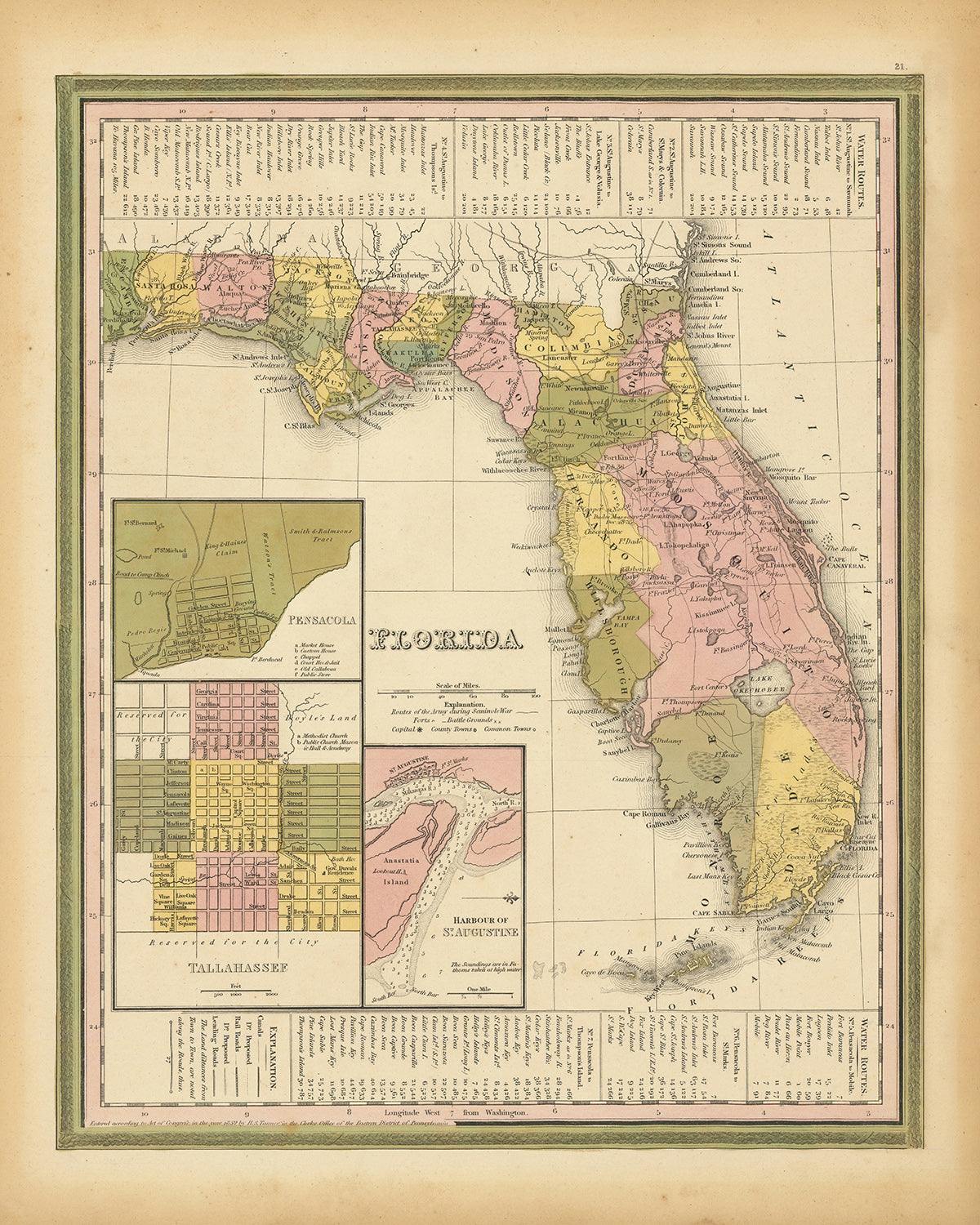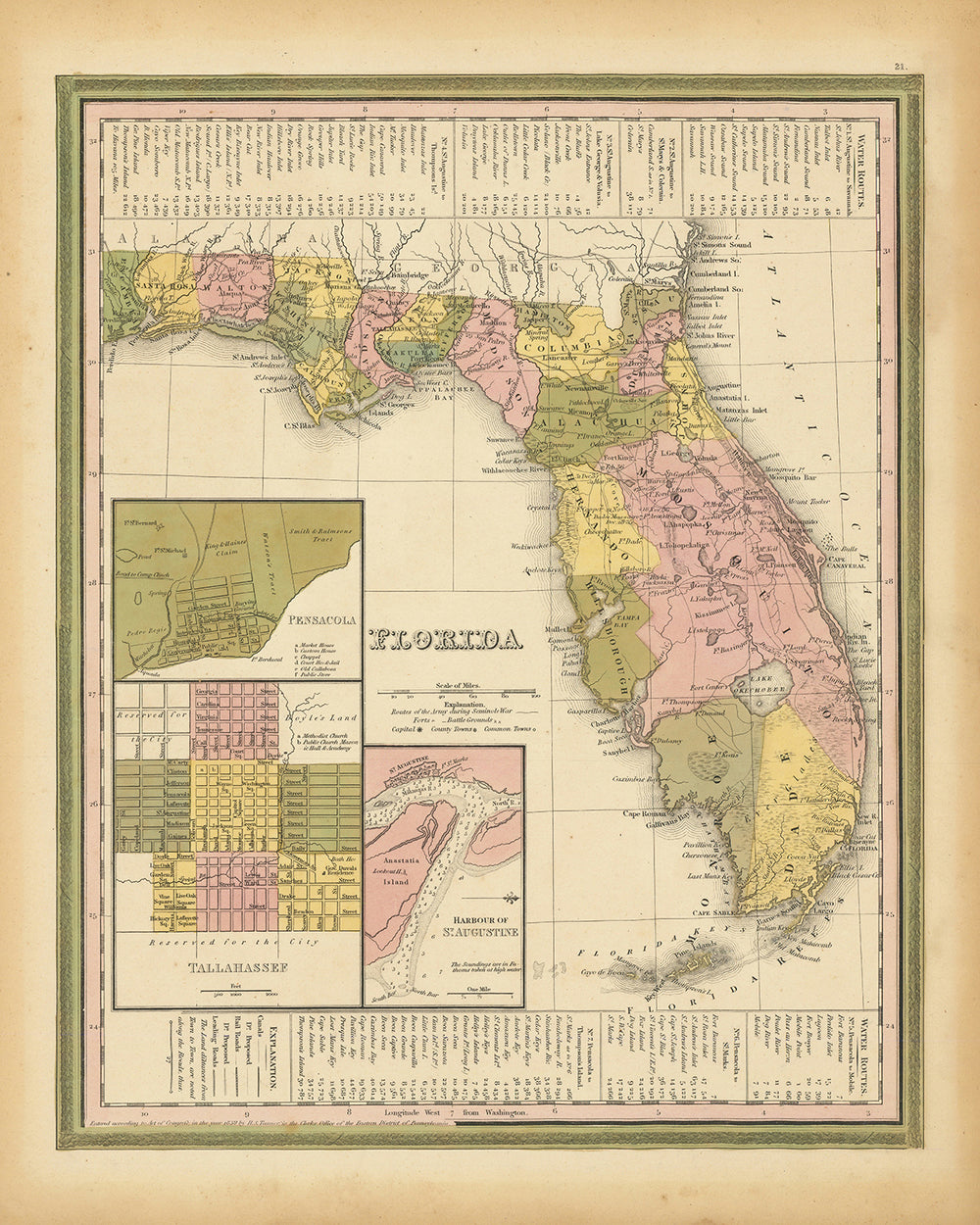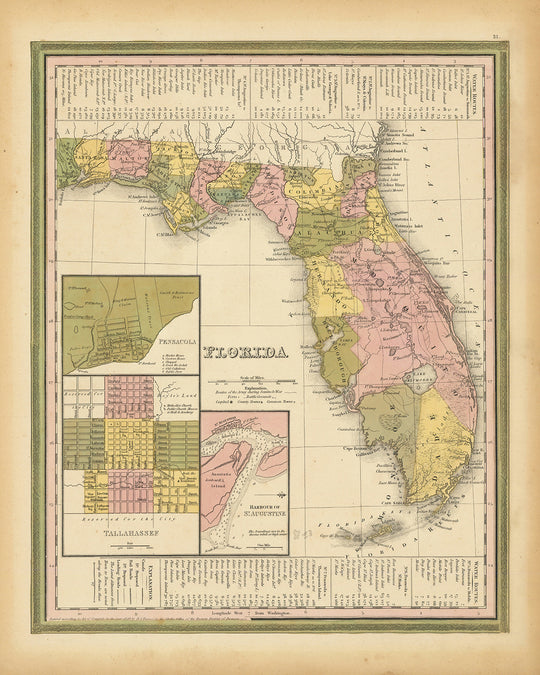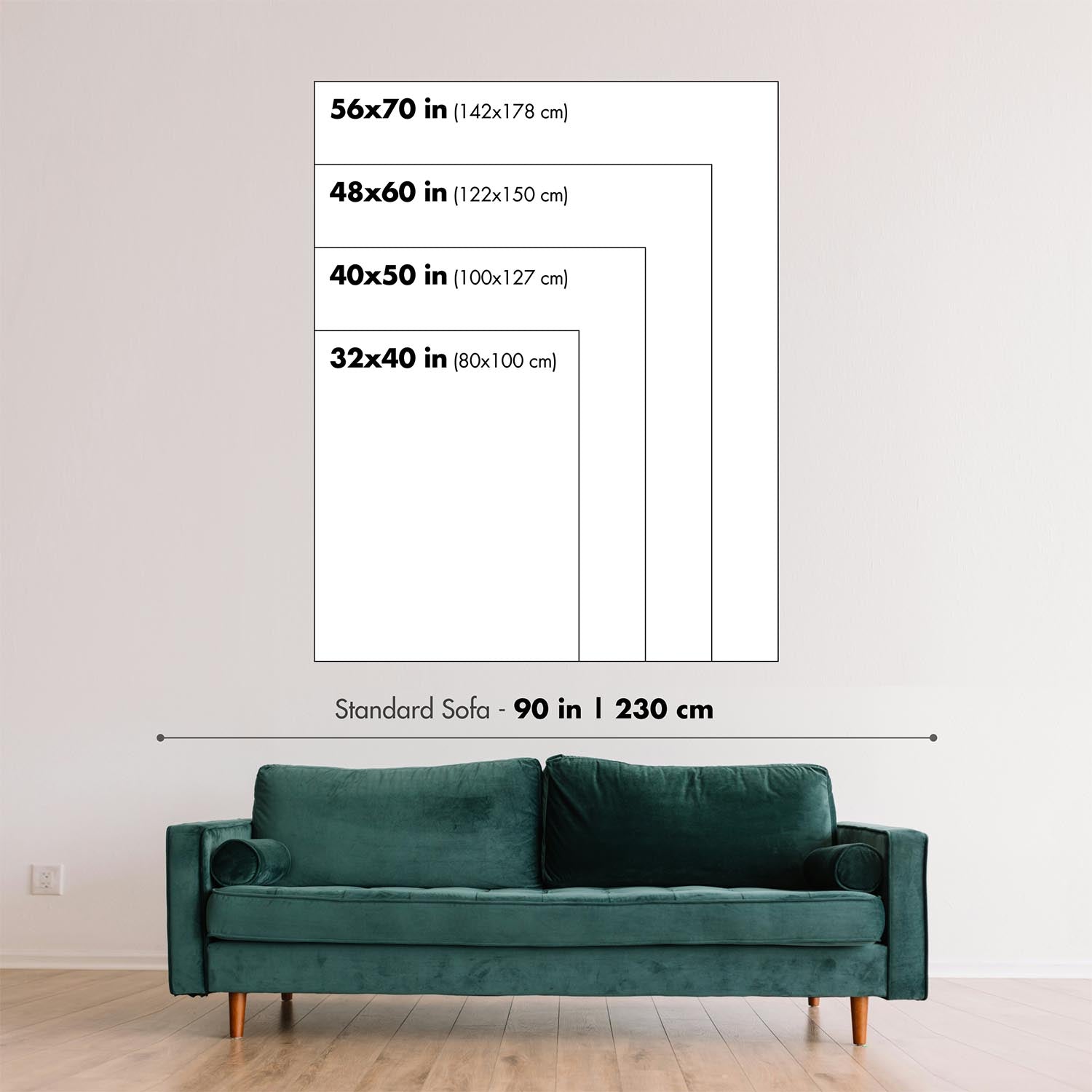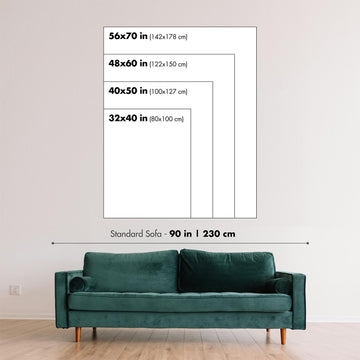- Handmade locally. No import duty or tax
- FREE Delivery by Christmas
- Love it or your money back (90 days)
- Questions? WhatsApp me any time
Own a piece of history
5,000+ 5 star reviews


Experience a rich tapestry of history with this captivating 1839 map of Florida by H. S. Tanner. This exceptional map, an artifact of early 19th century Florida, beautifully illustrates a time when many of the state's major cities were just nascent settlements or hadn't been established yet. Some of the modern metropolises you know today might even be spotted under their earlier names, serving as a fascinating testament to the region's dynamic evolution.
Tanner's superior craftsmanship allows this map to offer much more than geographical knowledge. It is an historical dialogue, highlighting the settlements that were officially founded by 1839, and gives viewers an intriguing perspective on the transformation of Florida over the centuries. This old map's charm and value come not only from what it reveals but also from what it omits – those yet-to-be-founded towns that would one day shape Florida's identity. This unique interplay of revealed and concealed history makes this map an invaluable keepsake for collectors and history enthusiasts alike.
List of 30 settlements with descriptions (in order of modern day population size)
- Jacksonville (1791): Florida's most populous city, known for its extensive park system.
- Miami (1825): A major center for finance, commerce, culture, arts, and international trade.
- Tampa (1824): Home to a diverse range of architectural styles and historic districts.
- St. Petersburg (1833): Known for its beautiful beaches and a vibrant arts scene.
- Tallahassee (1824): The capital of Florida and an important center for trade and agriculture.
- Fort Lauderdale (1838): Known as the "Venice of America" due to its expansive and intricate canal system.
- Gainesville (1821): The city is home to the University of Florida, the state's largest and oldest university.
- Clearwater (1821): Known for its beautiful beaches and as a spiritual headquarters for the Church of Scientology.
- Pensacola (1698): Florida's oldest European settlement, its natural harbor has long made it a hub of naval activity.
- Key West (1822): The southernmost point in the continental United States, known for its conch-style houses and coral reefs.
- Palm Beach (1838): Known for its wealthy living and high-end boutiques.
- St. Augustine (1565): The oldest continuously inhabited European-established settlement in the continental US.
- Sarasota (1824): Known for its vibrant arts community, environmental and scientific institutes, and its many sandy beaches.
- New Smyrna Beach (1768): Known for its small town charm, excellent beaches and rich history.
- Fernandina Beach (1821): Known for its well-preserved Victorian-era architecture.
- Naples (1824): Known for its high-end shopping, golf courses, and proximity to the wilderness of the Everglades.
- Apalachicola (1827): Known for its seafood, particularly oysters, and historic downtown.
- Ft. Myers (1821): Known for its beaches, fishing, and shopping, it is a gateway to the Southwest Florida region.
- Tarpon Springs (1823): Known for its historic downtown district, sponge docks, and Greek community.
- Palatka (1821): Known for its historic district, it was a major trading post in Florida's early history.
- Sanford (1836): Known for its downtown historic district filled with art galleries, shops, and restaurants.
- Micanopy (1821): Known for its antique stores and canopy roadways of live oaks draped in Spanish moss.
- Key Largo (1822): Known as the Dive Capital of the World because of its living coral reef a few miles offshore.
- Mount Dora (1836): Known for its antique shops and annual festivals.
- Dade City (1824): Known for its antique stores and old Florida charm.
- Punta Gorda (1824): Known for its historic district, parks, and Fisherman's Village.
- Fellsmere (1838): Known for its Frog Leg Festival, which draws thousands of visitors.
- Indian Key (1824): Once the county seat for Dade County, it is now an uninhabited ghost town and state park.
Notable boundaries, rivers, canyons, indian territories, and natural phenomena
- St. Johns River: The longest river in Florida, known for its recreational activities.
- Everglades National Park: A significant feature known for its unique ecosystem.
- Seminole Indian Territory: Known for the Seminole Wars, the land is rich in history.
Historical events between 1810 and 1840
- The First Seminole War (1817-1818): Andrew Jackson invades Spanish Florida and claims it for the United States.
- Adams-Onís Treaty (1819): Spain cedes Florida to the U.S., effective in 1821.
- Second Seminole War (1835-1842): The longest and most costly of the Indian conflicts.
- Territorial Period (1822-1845): During this period, Florida transitioned from a frontier territory into a state.
Please double check the images to make sure that a specific town or place is shown on this map. You can also get in touch and ask us to check the map for you.
This map looks great at all sizes: 12x16in (30.5x41cm), 16x20in (40.5x51cm), 18x24in (45.5x61cm), 24x30in (61x76cm), 32x40in (81.5x102cm), 40x50in (102x127cm), 48x60in (122x153cm) and 56x70in (142x178cm), but it looks even better when printed large.
I can create beautiful, large prints of this map up to 100in (254cm). Please get in touch if you're looking for larger, customised or different framing options.
The model in the listing images is holding the 16x20in (40.5x51cm) version of this map.
The fifth listing image shows an example of my map personalisation service.
If you’re looking for something slightly different, check out my main collection of USA and North America maps.
Please contact me to check if a certain location, landmark or feature is shown on this map.
This would make a wonderful birthday, Christmas, Father's Day, work leaving, anniversary or housewarming gift for someone from the areas covered by this map.
This map is available as a giclée print on acid free archival matte paper, or you can buy it framed. The frame is a nice, simple black frame that suits most aesthetics. Please get in touch if you'd like a different frame colour or material. My frames are glazed with super-clear museum-grade acrylic (perspex/acrylite), which is significantly less reflective than glass, safer, and will always arrive in perfect condition.
This map is also available as a float framed canvas, sometimes known as a shadow gap framed canvas or canvas floater. The map is printed on artist's cotton canvas and then stretched over a handmade box frame. We then "float" the canvas inside a wooden frame, which is available in a range of colours (black, dark brown, oak, antique gold and white). This is a wonderful way to present a map without glazing in front. See some examples of float framed canvas maps and explore the differences between my different finishes.
For something truly unique, this map is also available in "Unique 3D", our trademarked process that dramatically transforms the map so that it has a wonderful sense of depth. We combine the original map with detailed topography and elevation data, so that mountains and the terrain really "pop". For more info and examples of 3D maps, check my Unique 3D page.
For most orders, delivery time is about 3 working days. Personalised and customised products take longer, as I have to do the personalisation and send it to you for approval, which usually takes 1 or 2 days.
Please note that very large framed orders usually take longer to make and deliver.
If you need your order to arrive by a certain date, please contact me before you order so that we can find the best way of making sure you get your order in time.
I print and frame maps and artwork in 23 countries around the world. This means your order will be made locally, which cuts down on delivery time and ensures that it won't be damaged during delivery. You'll never pay customs or import duty, and we'll put less CO2 into the air.
All of my maps and art prints are well packaged and sent in a rugged tube if unframed, or surrounded by foam if framed.
I try to send out all orders within 1 or 2 days of receiving your order, though some products (like face masks, mugs and tote bags) can take longer to make.
If you select Express Delivery at checkout your order we will prioritise your order and send it out by 1-day courier (Fedex, DHL, UPS, Parcelforce).
Next Day delivery is also available in some countries (US, UK, Singapore, UAE) but please try to order early in the day so that we can get it sent out on time.
My standard frame is a gallery style black ash hardwood frame. It is simple and quite modern looking. My standard frame is around 20mm (0.8in) wide.
I use super-clear acrylic (perspex/acrylite) for the frame glass. It's lighter and safer than glass - and it looks better, as the reflectivity is lower.
Six standard frame colours are available for free (black, dark brown, dark grey, oak, white and antique gold). Custom framing and mounting/matting is available if you're looking for something else.
Most maps, art and illustrations are also available as a framed canvas. We use matte (not shiny) cotton canvas, stretch it over a sustainably sourced box wood frame, and then 'float' the piece within a wood frame. The end result is quite beautiful, and there's no glazing to get in the way.
All frames are provided "ready to hang", with either a string or brackets on the back. Very large frames will have heavy duty hanging plates and/or a mounting baton. If you have any questions, please get in touch.
See some examples of my framed maps and framed canvas maps.
Alternatively, I can also supply old maps and artwork on canvas, foam board, cotton rag and other materials.
If you want to frame your map or artwork yourself, please read my size guide first.
My maps are extremely high quality reproductions of original maps.
I source original, rare maps from libraries, auction houses and private collections around the world, restore them at my London workshop, and then use specialist giclée inks and printers to create beautiful maps that look even better than the original.
My maps are printed on acid-free archival matte (not glossy) paper that feels very high quality and almost like card. In technical terms the paper weight/thickness is 10mil/200gsm. It's perfect for framing.
I print with Epson ultrachrome giclée UV fade resistant pigment inks - some of the best inks you can find.
I can also make maps on canvas, cotton rag and other exotic materials.
Learn more about The Unique Maps Co.
Map personalisation
If you're looking for the perfect anniversary or housewarming gift, I can personalise your map to make it truly unique. For example, I can add a short message, or highlight an important location, or add your family's coat of arms.
The options are almost infinite. Please see my map personalisation page for some wonderful examples of what's possible.
To order a personalised map, select "personalise your map" before adding it to your basket.
Get in touch if you're looking for more complex customisations and personalisations.
Map ageing
I have been asked hundreds of times over the years by customers if they could buy a map that looks even older.
Well, now you can, by selecting Aged before you add a map to your basket.
All the product photos you see on this page show the map in its Original form. This is what the map looks like today.
If you select Aged, I will age your map by hand, using a special and unique process developed through years of studying old maps, talking to researchers to understand the chemistry of aging paper, and of course... lots of practice!
If you're unsure, stick to the Original colour of the map. If you want something a bit darker and older looking, go for Aged.
If you are not happy with your order for any reason, contact me and I'll get it fixed ASAP, free of charge. Please see my returns and refund policy for more information.
I am very confident you will like your restored map or art print. I have been doing this since 1984. I'm a 5-star Etsy seller. I have sold tens of thousands of maps and art prints and have over 5,000 real 5-star reviews. My work has been featured in interior design magazines, on the BBC, and on the walls of dozens of 5-star hotels.
I use a unique process to restore maps and artwork that is massively time consuming and labour intensive. Hunting down the original maps and illustrations can take months. I use state of the art and eye-wateringly expensive technology to scan and restore them. As a result, I guarantee my maps and art prints are a cut above the rest. I stand by my products and will always make sure you're 100% happy with what you receive.
Almost all of my maps and art prints look amazing at large sizes (200cm, 6.5ft+) and I can frame and deliver them to you as well, via special oversized courier. Contact me to discuss your specific needs.
Or try searching for something!







